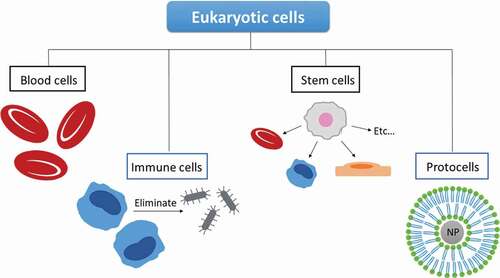Figures & data
Figure 1. Representative scheme of interesting bacterial properties for drug delivery systems: self-propulsion thanks to the use of flagella and pili; taxis movement of bacteria toward nutrients; stimuli-responsive bacteria that can be activated with an adequate stimuli; batofection or the ability to transfect their plasmid material to cells; protein-production by the bacteria.

Figure 2. Attachment of mesoporous silica nanoparticles to the surface of bacteria through click chemistry means [Citation110].
![Figure 2. Attachment of mesoporous silica nanoparticles to the surface of bacteria through click chemistry means [Citation110].](/cms/asset/d17094ae-8dae-4702-b8ec-014c6bd5d670/iedd_a_2029844_f0002_oc.jpg)
Figure 3. Illustration of the mobility and penetration studies of the biohybrid system using a nutrient-rich collagen 3D gel [Citation110].
![Figure 3. Illustration of the mobility and penetration studies of the biohybrid system using a nutrient-rich collagen 3D gel [Citation110].](/cms/asset/a7834449-ad66-4c44-b108-6c54af5480c6/iedd_a_2029844_f0003_oc.jpg)
Figure 4. Representative scheme of different types of cells and cell-mimicking platforms for drug delivery.

Figure 5. Illustration scheme and confocal images of the fabrication of the biohybrid platform by combining mesenchymal stem cells with mesoporous silica nanoparticles [Citation154].
![Figure 5. Illustration scheme and confocal images of the fabrication of the biohybrid platform by combining mesenchymal stem cells with mesoporous silica nanoparticles [Citation154].](/cms/asset/b91af3d8-a61b-4e8d-9073-8ce60c1d225e/iedd_a_2029844_f0005_oc.jpg)
